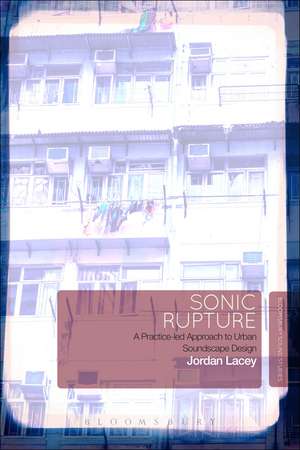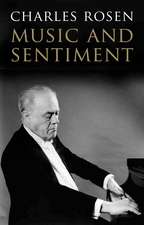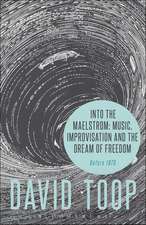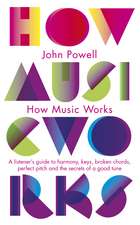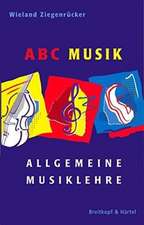Sonic Rupture: A Practice-led Approach to Urban Soundscape Design
Autor Dr Jordan Laceyen Limba Engleză Paperback – 27 dec 2017
| Toate formatele și edițiile | Preț | Express |
|---|---|---|
| Paperback (1) | 236.09 lei 6-8 săpt. | |
| Bloomsbury Publishing – 27 dec 2017 | 236.09 lei 6-8 săpt. | |
| Hardback (1) | 717.79 lei 6-8 săpt. | |
| Bloomsbury Publishing – iun 2016 | 717.79 lei 6-8 săpt. |
Preț: 236.09 lei
Preț vechi: 271.93 lei
-13% Nou
Puncte Express: 354
Preț estimativ în valută:
45.18€ • 49.06$ • 37.95£
45.18€ • 49.06$ • 37.95£
Carte tipărită la comandă
Livrare economică 22 aprilie-06 mai
Preluare comenzi: 021 569.72.76
Specificații
ISBN-13: 9781501338571
ISBN-10: 1501338579
Pagini: 208
Ilustrații: 57 mono images
Dimensiuni: 228 x 153 x 18 mm
Greutate: 0.28 kg
Ediția:NIPPOD
Editura: Bloomsbury Publishing
Colecția Bloomsbury Academic
Locul publicării:New York, United States
ISBN-10: 1501338579
Pagini: 208
Ilustrații: 57 mono images
Dimensiuni: 228 x 153 x 18 mm
Greutate: 0.28 kg
Ediția:NIPPOD
Editura: Bloomsbury Publishing
Colecția Bloomsbury Academic
Locul publicării:New York, United States
Caracteristici
Five distinct approaches to urban soundscape design, each with practical descriptions and theoretical discussions that enhance urban sound practices
Notă biografică
Jordan Lacey is a sound artist and urban design researcher based in Melbourne, Australia.
Cuprins
AcknowledgmentsIntroductionShaping Sonic CitiesCreating New NaturesInterlude: The Urban RoarNoise MeditationsSonic RuptureConclusionReferencesIndex
Recenzii
An honest and refreshing take on the urban side of the acoustic ecology equation . The book's overall project is one that is grounded in an artistic inquiry, and much of its research content and knowledge is informed by the intuitive act of making by an urban dweller. It is an excellent example of research-creation, and a welcome addition to the growing body of work in sound studies.
Sonic Rupture doubles as a sort of manual on acoustic design of public spaces. In describing his projects and approaches, Lacey spares no technical or organisational detail, providing easily applicable strategies ... Offering valuable insights and innovative approaches to soundscape studies and design, the book certainly deserves to be read with an open mind.
I warmly recommend this book to anyone drawn to learn more about the role sound art can play in analyzing, reflecting on, and improving urban soundscapes ... [It offers] interesting openings ... for engaging with and perhaps improving our everyday urban sonic environments.
[Sonic Rupture has] opened a new possible view on the development of music (as a limited field of sound).
Guiding us expertly through aesthetic and intellectual reflections and the practice of his own work, Jordan Lacey literally ruptures the biophilic dream of traditional acoustic ecology and persuasively collapses its idealisation of nature. In its stead he develops the fundamentals for an Urban Soundscape Design that engages the complexity of place and placement. Providing a timely regeneration of soundscape studies, Sonic Rupture breaks with the complacency of a dialectical hearing, and creates a sonic access to land as an affective earth where we hear noise not as a nuisance but as a sign of limitless potential; and where sound artists and listeners have a mandate for political activism through their joyful participation in the diversification of the urban crust.
Sonic Rupture is a timely and provocative intervention in the field of soundscape studies that will be of great interest to theorists and practitioners alike. Combining the insights offered by affect theory with urban sound design practices, Jordan Lacey innovatively counters acoustic ecology's moralistic characterisations of both the noise of the city and quietude of nature, providing an alternative framework through which to address the politics and potentialities of sound.
While many have abandoned Acoustic Ecology in favor of newer, less encumbered terms, Jordan Lacey argues for its enduring relevance while also offering some much-needed updates. His arguments compel us to embrace its legacy by demonstrating a possible way forward for the field. In addition to being a passionate and compelling account of artistic praxis, Sonic Rupture offers some of the most vital thinking about Acoustic Ecology to be articulated in a generation.
Sonic Rupture doubles as a sort of manual on acoustic design of public spaces. In describing his projects and approaches, Lacey spares no technical or organisational detail, providing easily applicable strategies ... Offering valuable insights and innovative approaches to soundscape studies and design, the book certainly deserves to be read with an open mind.
I warmly recommend this book to anyone drawn to learn more about the role sound art can play in analyzing, reflecting on, and improving urban soundscapes ... [It offers] interesting openings ... for engaging with and perhaps improving our everyday urban sonic environments.
[Sonic Rupture has] opened a new possible view on the development of music (as a limited field of sound).
Guiding us expertly through aesthetic and intellectual reflections and the practice of his own work, Jordan Lacey literally ruptures the biophilic dream of traditional acoustic ecology and persuasively collapses its idealisation of nature. In its stead he develops the fundamentals for an Urban Soundscape Design that engages the complexity of place and placement. Providing a timely regeneration of soundscape studies, Sonic Rupture breaks with the complacency of a dialectical hearing, and creates a sonic access to land as an affective earth where we hear noise not as a nuisance but as a sign of limitless potential; and where sound artists and listeners have a mandate for political activism through their joyful participation in the diversification of the urban crust.
Sonic Rupture is a timely and provocative intervention in the field of soundscape studies that will be of great interest to theorists and practitioners alike. Combining the insights offered by affect theory with urban sound design practices, Jordan Lacey innovatively counters acoustic ecology's moralistic characterisations of both the noise of the city and quietude of nature, providing an alternative framework through which to address the politics and potentialities of sound.
While many have abandoned Acoustic Ecology in favor of newer, less encumbered terms, Jordan Lacey argues for its enduring relevance while also offering some much-needed updates. His arguments compel us to embrace its legacy by demonstrating a possible way forward for the field. In addition to being a passionate and compelling account of artistic praxis, Sonic Rupture offers some of the most vital thinking about Acoustic Ecology to be articulated in a generation.
